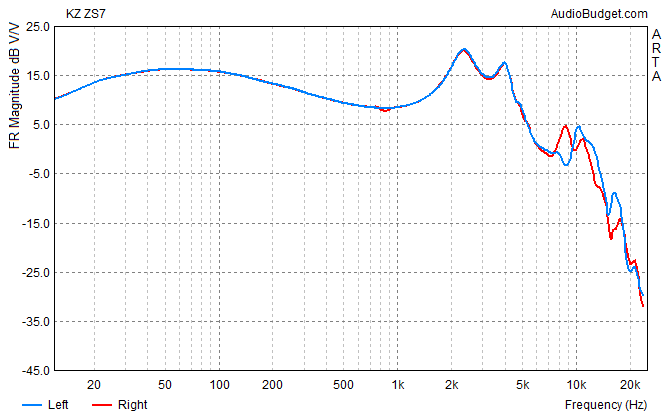KZ ZS7
ø10mm Dynamic Driver + 4 × Balanced Armatures
One of the more recent iterations in KZ's ZS series are the ZS7, and they were clearly designed after the ZS6, with the only differences in design are the tilted cutouts on the backplate, and a lip around the tip of each nozzle, to give a better grip for the ear tips. As for the cable - a great improvement, but for some reason they still used a memory wire ear loops instead of pre-shaped ones (unlike other recent earphones by KZ).
However, when it comes to sound, the differences are much more evident. We're talking about an extended and powerful bass, not overwhelming and of high quality, similarly to ZS6, but even more pronounced. Along with that, we get edgier upper-mids/lower-treble, which causes shoutiness and discomfort when certain sounds are played - an issue the ZS6 doesn't have. As for the highs, the ZS7 are complete opposites to the ZS6: the highs are veiled and unsatisfying, but are still accurate.
All in all, these are good earphones, but just like the ZS6, they also have significant disadvantages that make they less relevant, considering the price point at which these are sold and considering the amount of balanced armatures using in these earphones. With some balancing tweaks, these could have been one of KZ's best offerings to this day.
Pros
- Very good sound quality and accuracy.
- Powerful bass and very deep sub-bass response.
- Extremely loud and very easy to drive even with weak sources.
- Detachable cable, which extends the lifespan of these earphones.
Cons
- Intrusive mids that make vocals and certain instruments a bit uncomfortable to listen to after a while.
- Although comfortable to listen to - the upper-treble is veiled and unremarkable.
- The channel splitting wires are ridiculously long and the Y split is way lower than necessary, making the cable quite dangly and difficult to control. (Despite that, the inline remote isn't too far from the mouth)
- KZ used the memory-wire ear loops again, for some reason.
Ear Tips - Single-Flange:
S+M+L, starline, black, ø4.5mm bores
Housings:
Metal, ø5.5mm nozzles (ø5mm bores)
Remote:
Plastic (matte), single-button
Cable:
Silicone (braided), 130cm, extra-soft, straight, memory-wire ear loops
Plug:
TPE, 90° angled, wide, soft strain relief
As I said with ZS6: When it comes to comfort, I prefer ZS7 over the ZS5. The different shape and angle of the nozzles actually suit my ears better, and I could wear these earphones comfortably for hours. I'm not a huge fan of the memory-wire ear loops on the cable, though. The lip around the nozzle is a subtle but a very welcome addition, as it keeps a better grip of the ear tips and prevents them from sliding off of the nozzles.
Very powerful and high-quality bass reproduction. Very extended so you can enjoy some serious bass rumble when listening to electronic music. Even on lighter or vocal-oriented music styles, I don't consider the bass to be exaggerated. It makes the sound signature more V-shaped, but also more fun and more appealing to the common listener.
The first balancing issue in this case is how the upper-mids were bumped. When listening to some normalized audio track, speach or an audiobook, you might not notice anything wrong with how the mids sound. Then some sudden sound of a new message or notification from your favorite social network pops out, and your mind gets blown by it. This is a tiny example of the problem, but is sufficient to conclude that the upper-mids are simply too edgy, and unless you turn down the volume (to a degree where the upper-treble will be inaudible), you won't find the listening experience to be consistently comfortable.
These earphones have 4 balanced armatures in them, and yet the upper-treble, for which these BAs are responsible, sounds very disappointing. It's not the quality that I'm concerned about, because the quality is quite good. It's the "amount" of treble you get, which in turn means the amount of detail you get out of these earphones, and it's just not enough for this price point. If KZ were trying to fix ZS6's piercing treble by drastically tuning it down, then they just created the opposite problem - not enough upper-treble. The tuning could have been done better for sure.
Frequency Response
Published on 2019-05-09 17:44:26 (GMT)










